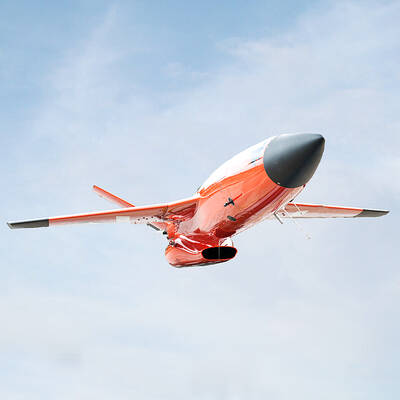The oil rush has come to western Canada, with the US and China jockeying for position in what is potentially the world's biggest source of petroleum, known as the Alberta oil sands.
The potential of the oil sands has been known for decades, but with energy prices soaring and heightened fears of a global supply crunch, a growing number of producers from around the world are stepping up efforts to find ways to explore and extract oil.
The oil sands -- deposits of bitumen, a heavy black viscous oil that needs extensive treatment to be converted into an upgraded crude oil -- contain 175 billion barrels of "proven reserves," the largest in the world outside Saudi Arabia.
For an oil-hungry world, the Alberta sands represents the best opportunity for boosting supplies, some analysts say.
"Can you name me another country in the world that can increase its oil production right now?" asks Greg Stringham, vice president at the Canadian Association of Petroleum Producers.
High Costs
Extracting oil from the sands costs as much as US$12 per barrel, making it more costly than crude from other sources. But industry officials say a market price of more than US$25 a barrel will allow oil from the sands to be profitable.
Canada's total oil production is about 2.5 million barrels per day, of which 80 percent is exported to refineries in the US. Canada supplies about 16 percent of US exports, and 10 percent of all US petroleum.
As producers find new ways to extract and treat the bitumen, Canada could diversify its exports -- and China is among the countries in line.
China's interest in Canada's oil is seen as one of the reasons for the visit of President Hu Jintao (
Industry officials say Canada is likely to boost oil production to about 4 million barrels a day, thus providing an extra 1.5 million barrels to a global economy thirsty for more oil.
Chinese oil firms as well as others, including France's Total SA, are seeking partnerships with their Canadian counterparts as they bid for rights to sands -- found in an area of 140,800km2 of primarily northern Alberta.
Pacific pipeline
PetroChina is in talks with Canada's Enbridge meanwhile on the construction of a pipeline that would transport some 400,000 barrels per day from Fort McMurray, Alberta, to the Pacific coast, for an estimated cost of US$2.5 billion (US$2 billion).
Jiang Wenran (姜聞然), a political scientist at the University of Alberta, said China and Canada have mutual interests in cooperating in the oil sands exploitation. Both however are aware that China's ownership of a strategic asset is a politically sensitivity topic.
"All the major oil companies of China have offices in Calgary but they keep a very low profile," Jiang said. "They are aware of the Canadian debate about strategic and national security implications and they don't want to provoke anything so there are working in a discreet manner."
The US does not want to be left out of the action either. US Treasury Secretary John Snow recently visited the oil sands area, with Vice President Dick Cheney scheduled to follow.
"Now, the world is finally caught on to the fact that yes, these are actually developable," Alberta's Energy Minister Greg Melchin said. "It's a track everybody is interested in, including the United States."
"The United States has clearly begun to see this picture," said Sherry Burns, chief economist at BMO Nesbitt Burns.
"The global geopolitical implications are very important. Canada's role in the global economy and in the political sphere is about to increase dramatically in importance. It's nice to have a world-class bounty that the two largest economic powers desperately need," Burns said.

CROSS-STRAIT COLLABORATION: The new KMT chairwoman expressed interest in meeting the Chinese president from the start, but she’ll have to pay to get in Beijing allegedly agreed to let Chinese Nationalist Party (KMT) Chairwoman Cheng Li-wun (鄭麗文) meet with Chinese President Xi Jinping (習近平) around the Lunar New Year holiday next year on three conditions, including that the KMT block Taiwan’s arms purchases, a source said yesterday. Cheng has expressed interest in meeting Xi since she won the KMT’s chairmanship election in October. A source, speaking on condition of anonymity, said a consensus on a meeting was allegedly reached after two KMT vice chairmen visited China’s Taiwan Affairs Office Director Song Tao (宋濤) in China last month. Beijing allegedly gave the KMT three conditions it had to

STAYING ALERT: China this week deployed its largest maritime show of force to date in the region, prompting concern in Taipei and Tokyo, which Beijing has brushed off Deterring conflict over Taiwan is a priority, the White House said in its National Security Strategy published yesterday, which also called on Japan and South Korea to increase their defense spending to help protect the first island chain. Taiwan is strategically positioned between Northeast and Southeast Asia, and provides direct access to the second island chain, with one-third of global shipping passing through the South China Sea, the report said. Given the implications for the US economy, along with Taiwan’s dominance in semiconductors, “deterring a conflict over Taiwan, ideally by preserving military overmatch, is a priority,” it said. However, the strategy also reiterated

‘BALANCE OF POWER’: Hegseth said that the US did not want to ‘strangle’ China, but to ensure that none of Washington’s allies would be vulnerable to military aggression Washington has no intention of changing the “status quo” in the Taiwan Strait, US Secretary of Defense Pete Hegseth said on Saturday, adding that one of the US military’s main priorities is to deter China “through strength, not through confrontation.” Speaking at the annual Reagan National Defense Forum in Simi Valley, California, Hegseth outlined the US Department of Defense’s priorities under US President Donald Trump. “First, defending the US homeland and our hemisphere. Second, deterring China through strength, not confrontation. Third, increased burden sharing for us, allies and partners. And fourth, supercharging the US defense industrial base,” he said. US-China relations under

The Chien Feng IV (勁蜂, Mighty Hornet) loitering munition is on track to enter flight tests next month in connection with potential adoption by Taiwanese and US armed forces, a government source said yesterday. The kamikaze drone, which boasts a range of 1,000km, debuted at the Taipei Aerospace and Defense Technology Exhibition in September, the official said on condition of anonymity. The Chungshan Institute of Science and Technology and US-based Kratos Defense jointly developed the platform by leveraging the engine and airframe of the latter’s MQM-178 Firejet target drone, they said. The uncrewed aerial vehicle is designed to utilize an artificial intelligence computer